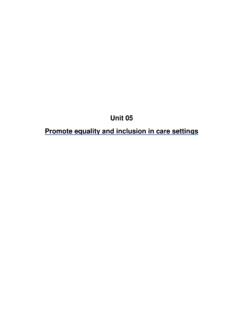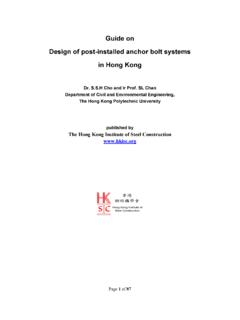Transcription of Unit 13 Move and position individuals in accordance with ...
1 Unit 13 Move and position individuals in accordance with their care plan 1 Unit purpose and aims Moving and handling is a very important aspect of care that demands a particular degree of knowledge and skill. This unit will explore the ways in which you move, handle and re- position individuals The learner will: 1. Understand current legislation in relation to moving and positioning individuals 2. Understand anatomy and physiology in relation to moving and positioning individuals 3. Be able to minimise risk before moving and positioning individuals 4. Be able to move and position an individual 5. Know when to seek advice and/or assistance from others when moving and positioning an individual 2 Current legislation, national guidelines, policies, procedures and protocols in relation to moving and positioning individuals The main laws for the protection of the health, safety and welfare of all care workers, service users, and others who might be employed in the workplace, are contained in the Health and Safety at Work Act (1974) and the regulations that are made under it.
2 Specifically, in relation to moving and handling, these are: The Management of Health and Safety at Work Regulations1999 The Manual Handling Operations Regulations 1992 (Amended2002) The Lifting Operations and Lifting Equipment Regulations1998 The Provision and Use of Work EquipmentRegulations1998 The Reporting of Injuries, Diseases and Dangerous Occurrences Regulations (2013). The Health and Safety at Work Act (1974) The Health and Safety at Work Act (1974) forms the basis of all health and safety legislation. Its primary aim is to safeguard the health, safety and welfare of all workers in all employment. It sets out the general duties that employers have towards employees and members of the public, and employees have to themselves and to each other. The following is a summary of the employer s and the employee s legal duties under the Health and Safety at Work Act.
3 The employer s duties To ensure as far as is reasonably practicable, the health and safety and welfare of all employees. In order to fulfill this obligation employers must: Make the workplace safe and free from risks to health Provide workplace policies and procedures Ensure that plant and machinery are safe and that safe systems of work are set and followed Assess health and safety risks and take action to reduce identified risks Appoint a competent person to assist with health and safety responsibilities Provide health and safety information, training and supervision for employees Provide adequate welfare and first aid facilities 3 Provide free protective clothing and equipment Set up emergency procedures Take precautions against dangers and provide appropriate safety signs Avoid the risk of injury from manual handling operations Report certain injuries, diseases and dangerous occurrences to the authorities.
4 The employee s duties Under this piece of legislation employees have a responsibility to: Take care of their own and other persons health and safety Co-operate with employers on health and safety issues Not to misuse or willfully damage anything provided for their health and safety. The Management of Health and Safety at Work Regulations (1999) This piece of legislation sets out the responsibilities of employers in relation to risk assessments. Regulation 3 states that every employer shall make a suitable and sufficient risk assessment which must be acted upon and reviewed on a regular basis. 4 The Manual Handling Operations Regulations 1992 (As amended 2002) The Manual Handling Operations Regulations (1992) define manual handling operations: A load is defined as: These regulations apply wherever people or objects are moved by hand or bodily force.
5 These regulations impose duties on both the employer and the employee. The employer s duties The principle requirements are to: AVOID the need for hazardous manual handling as far as is reasonably practicable ASSESS the risk of injury from any manual handling that cannot be avoided REDUCE the risk of injury from hazardous manual handling as far as is reasonably practicable REVIEW to ensure that changes are made to an assessment when required. The employee s duties To follow appropriate systems of work that have been laid down for their safety To make proper use of any equipment that has been provided to minimise the risk of injury To cooperate with their employer on health and safety matters to protect themselves and to protect others. The Lifting Operations and Lifting Equipment Regulations (1998) (LOLER) Any transporting or supporting of a load (including the lifting, putting down, pushing, pulling, carrying or moving thereof) by hand or bodily force.
6 Anything which is moveable an inanimate object, person or animal Any transporting or supporting of a load (including the lifting, putting down, pushing, pulling, carrying or moving thereof) by hand or bodily force. 5 If lifting equipment is provided at work then the LOLER regulations apply. These regulations apply to the use of lifting equipment, for example, hoists and slings. Under these regulations employers must ensure that lifting equipment meets the requirements of LOLER. The regulations generally require that lifting equipment provided for use at work is: Strong and stable enough for the particular use and is marked to indicate safe working loads Positioned and installed to minimise any risks Used safely Is examined and inspected where appropriate by a competent person Examined before being used for the first time, prior to any use and at regular intervals thereafter.
7 The employer s duties are: To ensure that equipment is suitable for use To maintain equipment in a safe condition so that people s health and safety is not put at risk To ensure that equipment is inspected so that it continues to be safe for use. Inspection should be carried out by a competent person To maintain records of all inspections. The employee s duties are: To follow any training and comply with their employer s instructions regarding safety Report any faults to employer Always use appropriate personal protective equipment Equipment should be marked to state that it is safe for use Employers must also ensure that any lifting operations are properly planned, appropriately supervised and carried out in a safe manner. 6 The Provision and Use of Work Equipment Regulations (1998) (PUWER) These regulations cover all equipment used at work including manual handling equipment, for example, slide sheets and handling boards.
8 These regulations require that equipment provided for use at work should be: Suitable for the intended purpose Safe for use, maintained in a safe condition and inspected at regular intervals Used only by people who have received adequate information, instruction and training Have suitable safety measures, markings and warnings. The employer s duties are: To ensure that equipment is suitable for use To maintain equipment in a safe condition so that people s health and safety is not put at risk To ensure that equipment is inspected so that it continues to be safe for use. Inspection should be carried out by a competent person To maintain records of all inspections. The employee s duties are: To follow any training and comply with their employer s instructions regarding safety Report any faults to employer Always use appropriate personal protective equipment.
9 The Reporting of Injuries, Diseases and Dangerous Occurrences Regulations (2013) RIDDOR RIDDOR obliges employers to report major injuries, dangerous occurrences and diseases. HSE states: If there is an accident connected with work (including an act of physical violence) and your employee, or a self-employed person working on your premises, suffers an over-seven-day injury, you must send a completed accident report form (F2508) to the enforcing authority within ten days. An over-seven-day injury is one which is not major but results in the injured person being away from work, or unable to do their normal work for more than seven days (including non-work days). 7 If an employee suffered a moving and handling injury that resulted in inability to do her/his normal work for more than seven days, the employer would be obliged to report.
10 Major injuries including: Fracture other than to fingers, thumbs or toes Amputation Dislocation of the shoulder, hip, knee orspine. Dangerous occurrences include: Collapse, overturning or failure of load-bearing parts of lifts and lifting equipment. Diseases: Including certain musculoskeletal disorders and upper limb disorders related to manual handling. The Equality Act (2010) Under the Equality Act it is unlawful for service providers to treat disabled people less favourably than other people for a reason related to their disability. This extends to the provision of the services themselves or the administration or management of the premises. Service providers now have a duty to make reasonable adjustments to the way they deliver their services so that disabled people can use them. Implications of the Equality Act on moving and handling This means that individuals who have a disability should never be treated in a way that is less favourable than an individual who does not have a disability.










